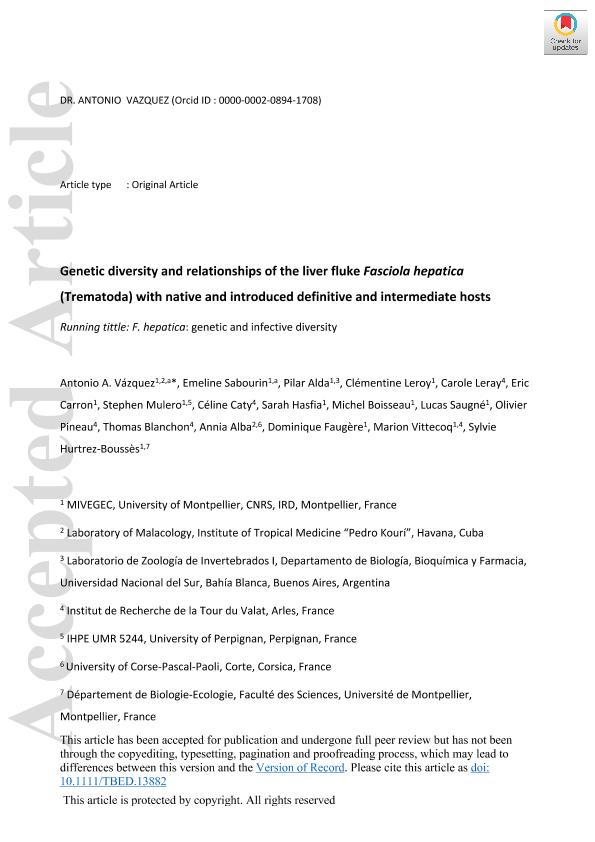Mostrar el registro sencillo del ítem
dc.contributor.author
Vázquez, Antonio A.
dc.contributor.author
Sabourin, Emeline
dc.contributor.author
Alda, Maria del Pilar

dc.contributor.author
Leroy, Clémentine
dc.contributor.author
Leray, Carole
dc.contributor.author
Carron, Eric
dc.contributor.author
Mulero, Stephen
dc.contributor.author
Caty, Céline
dc.contributor.author
Hasfia, Sarah
dc.contributor.author
Boisseau, Michel
dc.contributor.author
Saugné, Lucas
dc.contributor.author
Pineau, Olivier
dc.contributor.author
Blanchon, Thomas
dc.contributor.author
Alba, Annia
dc.contributor.author
Faugère, Dominique
dc.contributor.author
Vittecoq, Marion
dc.contributor.author
Hurtrez Boussès, Sylvie
dc.date.available
2021-05-06T15:51:01Z
dc.date.issued
2020-10-30
dc.identifier.citation
Vázquez, Antonio A.; Sabourin, Emeline; Alda, Maria del Pilar; Leroy, Clémentine; Leray, Carole; et al.; Genetic diversity and relationships of the liver fluke Fasciola hepatica (Trematoda) with native and introduced definitive and intermediate hosts; Wiley Blackwell Publishing, Inc; Transboundary And Emerging Diseases; 2020; 30-10-2020; 1-35
dc.identifier.issn
1865-1674
dc.identifier.uri
http://hdl.handle.net/11336/131516
dc.description.abstract
Fasciolosis is a worldwide spread parasitosis mainly caused by the trematode Fasciola hepatica. This disease is particularly important for public health in tropical regions, but it can also affect the economies of many developed countries due to large infections in domestic animals. Although several studies have tried to understand the transmission by studying the prevalence of different host species, only a few have used population genetic approaches to understand the links between domestic and wildlife infections. Here, we present the results of such genetic approach combined with classical parasitological data (prevalence and intensity) by studying domestic and wild definitive hosts from Camargue (southern France) where fasciolosis is considered as a problem. We found 60% of domestic hosts (cattle) infected with F. hepatica but lower values in wild hosts (nutria, 19%; wild boars, 4.5%). We explored nine variable microsatellite loci for 1,148 adult flukes recovered from four different populations (non-treated cattle, treated cattle, nutria and wild boars). Populations from the four groups differed, though we found a number of migrants particularly non-treated cattle and nutria. Overall, we detected 729 different multilocus genotypes (from 783 completely genotyped individuals) and only 46 genotypes repeated across samples. Finally, we experimentally infected native and introduced intermediate snail hosts to explore their compatibility with F. hepatica and assess the risks of fasciolosis expansion in the region. The introduced species Galba truncatula and Pseudosuccinea columella attained the higher values of overall compatibility in relation to the European species. However, concerning the origin, sympatric combinations of G. truncatula were more compatible (higher prevalence, intensity and survival) than the allopatric tested. According to our results, we should note that the assessment of epidemiological risks cannot be limited to a single host–parasite system, but should focus on understanding the diversity of hosts in the heterogeneous environment through space and time.
dc.format
application/pdf
dc.language.iso
eng
dc.publisher
Wiley Blackwell Publishing, Inc

dc.rights
info:eu-repo/semantics/openAccess
dc.rights.uri
https://creativecommons.org/licenses/by-nc-nd/2.5/ar/
dc.subject
DOMESTIC AND WILDLIFE INFECTION
dc.subject
FASCIOLOSIS
dc.subject
LYMNAEID SNAILS
dc.subject
POPULATION GENETICS
dc.subject.classification
Biología

dc.subject.classification
Ciencias Biológicas

dc.subject.classification
CIENCIAS NATURALES Y EXACTAS

dc.title
Genetic diversity and relationships of the liver fluke Fasciola hepatica (Trematoda) with native and introduced definitive and intermediate hosts
dc.type
info:eu-repo/semantics/article
dc.type
info:ar-repo/semantics/artículo
dc.type
info:eu-repo/semantics/publishedVersion
dc.date.updated
2021-04-23T16:37:27Z
dc.identifier.eissn
1865-1682
dc.journal.volume
2020
dc.journal.pagination
1-35
dc.journal.pais
Reino Unido

dc.journal.ciudad
Londres
dc.conicet.avisoEditorial
This is the peer reviewed version of the following article: "Genetic diversity and relationships of the liver fluke Fasciola hepatica (Trematoda) with native and introduced definitive and intermediate hosts", which has been published in final form at https://doi.org/10.1111/tbed.13882. This article may be used for non-commercial purposes in accordance with Wiley Terms and Conditions for Use of Self-Archived Versions.
dc.description.fil
Fil: Vázquez, Antonio A.. Instituto de Medicina Tropical “Pedro Kourí”; Cuba. Université Montpellier II; Francia. Centre National de la Recherche Scientifique; Francia
dc.description.fil
Fil: Sabourin, Emeline. Centre National de la Recherche Scientifique; Francia. Université Montpellier II; Francia
dc.description.fil
Fil: Alda, Maria del Pilar. Consejo Nacional de Investigaciones Científicas y Técnicas. Centro Científico Tecnológico Conicet - Bahía Blanca; Argentina. Universidad Nacional del Sur. Departamento de Biología, Bioquímica y Farmacia. Laboratorio de Zoología de Invertebrados I; Argentina. Centre National de la Recherche Scientifique; Francia. Université Montpellier II; Francia
dc.description.fil
Fil: Leroy, Clémentine. Centre National de la Recherche Scientifique; Francia. Université Montpellier II; Francia
dc.description.fil
Fil: Leray, Carole. Institut de Recherche de la Tour du Valat; Francia
dc.description.fil
Fil: Carron, Eric. Centre National de la Recherche Scientifique; Francia. Université Montpellier II; Francia
dc.description.fil
Fil: Mulero, Stephen. Centre National de la Recherche Scientifique; Francia. Université Montpellier II; Francia. Université de Perpignan Via Domitia; Francia
dc.description.fil
Fil: Caty, Céline. Institut de Recherche de la Tour du Valat; Francia
dc.description.fil
Fil: Hasfia, Sarah. Centre National de la Recherche Scientifique; Francia. Université Montpellier II; Francia
dc.description.fil
Fil: Boisseau, Michel. Centre National de la Recherche Scientifique; Francia. Université Montpellier II; Francia
dc.description.fil
Fil: Saugné, Lucas. Centre National de la Recherche Scientifique; Francia. Université Montpellier II; Francia
dc.description.fil
Fil: Pineau, Olivier. Institut de Recherche de la Tour du Valat; Francia
dc.description.fil
Fil: Blanchon, Thomas. Institut de Recherche de la Tour du Valat; Francia
dc.description.fil
Fil: Alba, Annia. Instituto de Medicina Tropical “Pedro Kourí”; Cuba. Università di Corsica Pasquale Paoli; Francia
dc.description.fil
Fil: Faugère, Dominique. Centre National de la Recherche Scientifique; Francia. Université Montpellier II; Francia
dc.description.fil
Fil: Vittecoq, Marion. Centre National de la Recherche Scientifique; Francia. Université Montpellier II; Francia. Institut de Recherche de la Tour du Valat; Francia
dc.description.fil
Fil: Hurtrez Boussès, Sylvie. Centre National de la Recherche Scientifique; Francia. Université Montpellier II; Francia
dc.journal.title
Transboundary And Emerging Diseases

dc.relation.alternativeid
info:eu-repo/semantics/altIdentifier/doi/http://dx.doi.org/10.1111/tbed.13882
dc.relation.alternativeid
info:eu-repo/semantics/altIdentifier/url/https://onlinelibrary.wiley.com/doi/10.1111/tbed.13882
Archivos asociados
